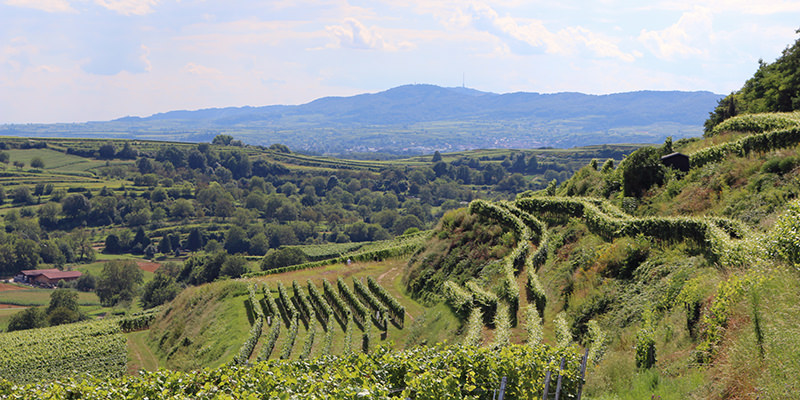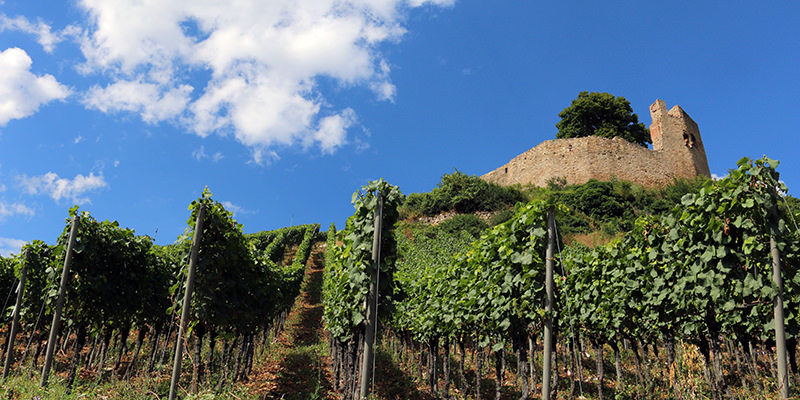German wine is nearly synonymous with Riesling, but there’s one region in Germany where Riesling is actually a rarity. South of the more famed regions of Mosel and Rheingau, and just miles across the border from Alsace, is Germany’s warmest, sunniest region: Baden. While Burgundy, California and Oregon may roar in dissent, it’s possible that Baden is, in fact, the ultimate Pinot country, and here’s why: The region doesn’t just specialize in a singular Pinot; it forms its identity based on the three major “Pinots” of the world: Pinot Noir, Pinot Blanc, and Pinot Gris. Often referred to as the “Burgundy” grapes by local winemakers, since the German names for these grapes all end in the suffix “-Burgunder,” the Pinots Noir/Blanc/Gris are all found in neighboring Alsace as well, but the styles are dramatically different on this side of the border.
While Baden is actually a fairly large region with several sub-zones, or Bereiche, its most famed wine-growing areas are located near the city of Freiburg in the narrow Rhine Rift Valley, located between the Vosges Mountains and the Black Forest (both are visible from some vineyard sites!). The Kaiserstuhl is the most important – and most scenic – of these areas, a cluster of ancient volcanic hills on which vines, sometimes terraced as in Portugal’s Douro, are grown. The limestone soil-heavy Breisgau, which backs up to the Black Forest, is also an important area for wine growing. And while delicious Riesling can be found in the northern reaches of Baden, why not discover a new favorite Pinot country by embracing the trio that makes Baden wine all its own?
Pinot Noir (Spatburgunder)
By far the king of Baden winemaking is Pinot Noir — ironic for a country so well known for its white wines. But with Baden’s warm, sunny climate, Pinot Noir (Spatburgunder) not only ripens fully, but can often over-ripen, with alcohol levels climbing past 15 percent in hot years. Perhaps due to Germany’s traditional quality system, which placed the ripest of wines at the top of the hierarchy, Baden producers have often operated under the “bigger is better” mentality, making either big, extracted, heavily oaked Pinot Noirs, or cheap, uninteresting bottles, which is probably why the wines in this region have been overlooked for so long. But in the past five to 10 years, winemakers have been choosing instead to focus on elegance, rather than ripeness, often coming together to taste more international styles of Pinot Noir, such as the classics from Burgundy.
While Baden Pinot Noir ranges from soft and fruity to muscular and powerful, it stands in stark contrast to the light, pale Pinot Noirs that come from nearby Alsace, which make up a mere 10 percent of that region’s production. Even within Baden, these wines are quite expressive of place; those from Kaisterstuhl tend to be broader and bolder, with a distinct black-rock minerality, whereas those from Breisgau are structured and built to age, sometimes mimicking the style (and price) of top Burgundy. The best wines are incredibly layered and have a hinged balance between lush, succulent fruit, finely grained minerality and a high-toned subtlety that leaves a craving for more.

Pinot Blanc (Weissburgunder)
Think of Pinot Blanc as the Chardonnay of Baden’s “Burgundy” grape trio; typically only known for making neutral, mellow, moderately-weighted white wines, Baden Pinot Blanc (a.k.a Weissburgunder) can be a bit of a chameleon. Though it isn’t considered one of the “noble” grape varieties across the river in Alsace, Pinot Blanc receives more time, care and expense than any other white grape in Baden. With slightly less weight than Chardonnay but more mouth-filling viscosity than Pinot Gris, this grape can be vinified in a plethora of ways, making it a surprising option.
Depending on the winemaker, Pinot Blanc can offer a huge range of styles, from fresh and quaffable, with round fruit flavors, or rich, savory and creamy. It’s common to find oak-aged Pinot Blanc in Baden, a style that doesn’t occur too commonly elsewhere, or the single-vineyard “grand cru” cuvee.
Pinot Gris (Grauburgunder)
With two different names that tend to indicate two very different styles of wine, Pinot Gris/Grigio is an odd grape to pin down. So of course it makes sense to throw a third name – Grauburgunder – into the mix and, with it, a third style as well. But Baden Pinot Gris tends to be a happy medium between the two major styles of this grape. It has the complexity and weight of Alsatian Pinot Gris, but without any sugar – Pinot Gris from Baden must always be dry, otherwise it is labeled Rulander – and the fresh, easy-drinking quality that Pinot Grigio lovers embrace.
Winemakers pay careful attention to Pinot Gris in Baden, so it’s not unusual to find grand cru bottlings of this grape as well, often intended to age. Techniques such as lees stirring, skin contact and barrel aging are also not uncommon, giving the amber-colored wines richness, texture and a certain savory note.

